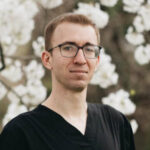Quick Links to the Sections Below
What’s the difference between Traditional Chinese Medicine and Biomedicine?
The concept of disease in Traditional Chinese Medicine (TCM) is both similar and different from what we are used to in biomedicine. In this post, I’ll explain the differences in both diagnosis and treatment between TCM and biomedicine, as well as the similarities. Before we start, I’d like to mention why I think these systems are so different and also why neither system should be seen as “wrong” or “right.”
The reason why TCM and biomedicine are different is because of their core philosophy. Biomedicine is based on a binary system of thought, while TCM is based on the dualist system of Yin/Yang. Binary systems are 1’s and 0’s, disease or no disease, something is wrong or right. In a dualist system, however, there are many decimal values between a 1 and a 0, disease is a web of relationships, and strict right and strict wrong do not exist. The only way to classify anything, and let’s just focus on disease here, is if it is more Yin or more Yang in nature.
There is no right or wrong between TCM and biomedicine because medicine is an individual experience. Certain conditions are better treated with biomedicine and certain ones with TCM, though the best results usually happen when both are used in concert.
TCM Disease Patterns and Treatment
At its core, TCM diagnosis is Yin/Yang theory. From biomedicine, we are familiar with the idea of organs in the body, which are like parts in a car. If a part breaks, then the solution is to either fix that part, replace it, or remove it entirely. TCM theory also says our bodies have organs, but these organs are like strands of a web or branches of a tree that spread into larger organ systems. Their functions branch, overlap, and interconnect in ways that makes their removal or replacement impossible. Therefore, the best way to treat them is to address their function itself. Each organ system has a natural state that is relatively more Yin or more Yang. Disease happens when that homeostasis is disrupted and the organ system becomes either too Yang or too Yin. This disruption happens in predictable ways, which are called disease patterns.
Some examples of disease patterns you might have heard are Liver Qi Stagnation, Kidney Yin Deficiency, Liver Yang Excess, Damp Heat, or Wind Cold, etc. The words that might not be immediately obvious, like Qi Stagnation or Damp Heat, are simply other ways of classifying disparities between Yin and Yang.
Treatment of disease pattens are typically done with acupuncture, Chinese herbs, or lifestyle changes. The least of these disease patterns can be treated by changes in lifestyle, like eating different foods or exercising more or less. If that doesn’t work, then more direct interventions like acupuncture, herbs, or some combination of the three will be used. Regardless of the specific method, the goal is to rebalance the relationship between Yin and Yang—thereby restoring normal function.
Biomedical Disease and Treatment
Biomedical diagnosis and treatment, as mentioned earlier, can be compared to the function of a car. Each part is important because of its role in the function of the whole, but few parts are so essential that they cannot be repaired or replaced if absolutely necessary. The function of each part, or organ, is accessed individually and is also treated individually unless a more systemic disease is present.
Most diseases in biomedicine also exist in the binary system. Enough signs and symptoms have to be present for a diagnosis, or none is given.
Treatment of these diseases does follow a similar path to disease treatment in TCM. Lifestyle and dietary changes are tried first when applicable, and if those fail, then more direct interventions like drugs or even surgery are used.
Similarities, Bridging the Gap, and Why Integrative Medicine Matters
Most similarities between TCM and biomedicine simply occur because both are focused on treating humans. We are in the West, primarily speaking English, so both culture and language engender overlap in the way we view medicine. Many of the terms and vocabulary we use are the same, which can cause confusion without context. I often tell patients that if I say your Liver has a problem, I don’t mean your physical liver. I mean the TCM idea of the Liver system and all its relevant relationships.
The best way to bridge the gap between these two systems is to use them in conjunction. As long as the context is clear, everyone benefits from both systems. We are fans of integrative medicine and thoroughly enjoy connecting with your biomedical providers and giving them our TCM thoughts on your case while getting better context for your biomedical diagnosis.
If one had to categorize them, I generally view the strength of TCM in preventative medicine and in treating certain chronic conditions, like irregular menstruation or digestive dysfunctions, where the treatment is not binary. Biomedicine, in contrast, has strengths in reactionary medicine and in conditions where a binary treatment is the best course. If you’re not sure which system would be the best for you, then choose both, and you’ll be the better for it!
Works Cited
Zagkorontskagia, E. (2021, November 15). The importance of Yin & Yang Balance in mind and body. Chenot. Retrieved January 4, 2022.



